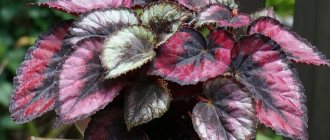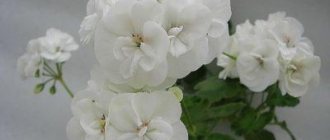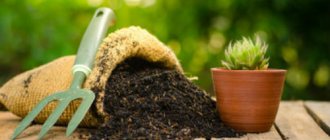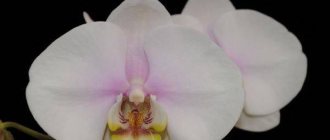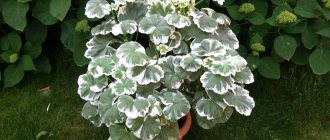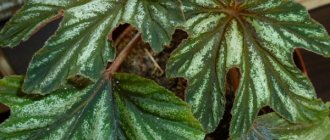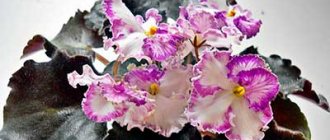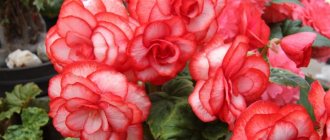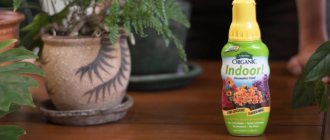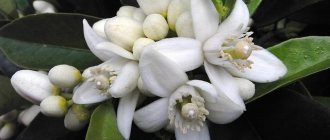Photo: kakuhazhivat.com Begonia is one of the most spectacular and elegant houseplants. Her flowers are like porcelain; once you see them, it is difficult to confuse them with something else. It is planted in flower beds, parks, gardens and squares. There are about 1000 varieties of begonia in the world and several times more hybrid varieties. There are no two identical flowerpots, each of them is very individual.
Origin of begonia and distinctive features
There are more than 1 thousand species of begonias in nature. The largest number of varieties is found in South America, followed by Asia (India, the Himalayas, Sri Lanka), and western Africa in third place. There is an assumption that Africa is the birthplace of begonias, from here they spread to Asia and America. In the wild, plants are found in humid subtropics and mountains.
Begonia in the wild
The family was first described by the French botanist Charles Plumier. In 1683, under the leadership of the intendant of the French colonies, Michel Begon, he visited the islands of the Caribbean with an expedition. There the scientist discovered plants that were unknown at that time, gave them a description and named them after the organizer of the trip.
The begonias known today differ greatly from each other in size, shape, coloring of leaves and flowers. Some are perennial, others are annual. There are herbaceous and shrubby begonias, with creeping or thickened rhizomes. But there is also something in common that unites these plants into one family.
Characteristics of begonias:
- All types of begonias have an asymmetrical, oblique leaf;
- flowers are monoecious;
- perianths - brightly colored, unequal;
- the fruit with seeds looks like a capsule;
- all begonias grow in approximately the same natural conditions: diffused sunlight, high humidity, temperature +13... +22 ⁰C.
Video: the wealth of types and colors of a flower
Types of decorative deciduous begonias with photos and descriptions
Begonia has quite complex classification systems that divide plant species and varieties into different groups. Some divide them by the method of use in floriculture, others by the type of root system or method of propagation. We decided to do something simpler and conditionally divide begonia varieties into decorative deciduous and decorative flowering .
Beautiful flowering begonias.
It is believed that the “evolution” of decorative flowering begonias is significantly inferior to decorative deciduous varieties. If in flowering indoor begonias they mainly change only color variations and improve endurance, then in the process of creating ever new varieties of deciduous beauties, breeders have long surpassed seemingly any expectations. Different textures, effects, colors, variations of patterns are complemented by the ability to choose the sizes and shapes of leaves. And sometimes it seems that new varieties appear every day.
On a note! Begonias can be selected not just according to your taste, but also for interior design, textiles and even accessories. And although the old varieties are still in demand, it is fashionable new items that have returned begonia to the peak of popularity.
Among decorative flowering begonias, the hybrid varieties of tuberous begonia (Begonia x tuberhybrida) can boast the greatest variability. Among them you can sometimes find the most unexpected color variations. But deciduous begonias are dominated by hybrids of Begonia rex, which in catalogs and at exhibitions often appear as varieties of unknown origin, in which purely decorative characteristics are considered the main ones.
Decorative begonia "Casey Corwin". Decorative begonia "Casey Corwin".
Both begonias have something to look at. In this article we will introduce you to the most beautiful types of decorative deciduous begonias, leading in popularity ratings. They are valued for the unusual shape, texture and coloring of their leaves.
Begonias - flowers for apartments, gardens and offices
As an ornamental crop, begonia has been developing since 1856, when breeders began to create its hybrids. Tuberous, large-flowering varieties appeared, the most famous ones being bred in Belgium. Keeping these plants at home is not too difficult, otherwise they would not be so popular. Begonias are grown in open ground and on window sills; they are used for landscaping residential premises and offices, in compositions and separately. Flowers are planted in baskets and pots to decorate walls, furniture, and are also used as ground cover plants. Ever-flowering varieties are suitable for any flower beds, even carpet ones. Tuberous varieties are grown on balconies, verandas, and enclosed courtyards.
Begonia as a decoration for buildings
Care at home has its own nuances, for example, tuberous plants require a period of rest. All begonias love moist air, but do not tolerate damp soil. However, any novice gardener can grow this plant. After all, if something went wrong and the begonia began to dry out, you can take a cutting or a leaf and start growing the begonia again, taking into account past mistakes. The culture is able to reproduce even with a piece of leaf, which very quickly turns back into a lush and beautiful indoor plant.
Growing in open ground
Plants are planted in the garden when the threat of night frosts has passed. For planting, it is preferable to choose the western or eastern side of the site. The soil requires nutritious, well-drained soil, for which peat, sand or leaf soil are added to it. Begonias are planted in holes, placing them at the same level as they were in the pot. Water generously. A peg is stuck nearby for support. It is correct if the plants are shaded for the first 2 weeks. Shade can be created using non-woven material attached to four pegs.
Begonia is well suited for all types of outdoor flower beds
Basic care recommendations
- Lighting and temperature. The plant is a light-loving plant, but it loves diffused light and partial shade rather than direct light. The bright sun leads to wilting of flowers and burns of foliage, so when placed on southern loggias and balconies, shading is necessary. At home, southwestern or southeastern window sills are suitable for begonias. The optimal temperature is 20…24 ℃.
- Protected location with good ventilation. The flower is afraid of drafts, to which it reacts by dropping buds, and wind, which can break fragile shoots. At the same time, stagnant air also has a bad effect - the plant develops better on open balconies, verandas, and in the garden.
- Watering and humidity. Begonia does not tolerate stagnant water, so a drainage layer is necessary. It is better to water in the morning with warm, settled water, avoiding moisture getting on the leaves. To maintain the optimal humidity level (50-60%), place containers of water between the pots or humidify the air from a spray bottle. Foliage and flowers are not sprayed, so as not to provoke the appearance of brown spots and rot on leaf blades and petals.
- Feeding. The first feeding is carried out in the spring, after the tuber is completely covered with soil. Nitrogen-containing fertilizers are applied to increase green mass. Then they switch to complexes for flowering plants with a predominance of phosphorus and potassium. Feed every two weeks. The last feeding is carried out in September, after flowering, adding potassium fertilizers. Experienced begonia breeders note that the plant does not favor organic matter and chlorine-containing compounds.
- Regular removal of faded flowers. This procedure stimulates the formation of new buds and improves appearance. In addition, it is recommended to remove female flowers so that the plant does not waste energy on producing seeds.
Tuberous begonia is a dioecious plant that has male and female flowers.
Male flowers are larger in size, double, and lack seeds.
Varieties of root begonias
Everblooming
The main difference between the species is its constant flowering. You can plant such a plant in the garden in the summer, take it indoors for the winter, and it will bloom everywhere all year round. These are perennial herbaceous begonias. External signs, in addition to constant flowering, are rounded leaves and small height: tall - up to 36 cm, short - from 8 cm. Many varieties have been bred with green or burgundy leaves, white, yellow, pink or coral flowers, which, in turn, They can be terry (in the form of roses) or simple.
Examples of plants in the photo
Bada Bing WHITE Bada Bing Rose Bada Bing Scarlet Accord Purple
Terry Storyteller Lucenets
Coral
Indoor herbaceous begonias bloom in early spring and fully justify their name. The flowers are painted in different shades of red, and the branched flower stalks hanging down under the weight of the buds are very similar to corals. The leaves also look romantic: elongated, matte, speckled, with jagged edges reminiscent of angel wings. Begonias look most impressive in pots on stands. They are very unpretentious in care. Bush height - up to 90 cm.
Peduncles resemble corals in both shape and color
Deciduous begonias
The species is famous for the decorativeness of its leaves, and the flowers of deciduous begonias are small and inconspicuous. These are often non-flowering perennial plants. They differ from other species in their capriciousness. So, leaf begonias cannot be kept in the open air, that is, these begonias love greenhouse conditions, high humidity, and diffused light. In the country house or on an open balcony they will die. The main feature of the species is large (15–20 cm) and beautiful leaves. They can be decorated with colored pearl spots, exquisite patterns, contrasting colors, silver glitter or mother-of-pearl shimmer. The stems are pubescent, the reverse side of the leaves usually has a red tint.
Photo gallery: Deciduous begonias
Begonia Royal
Begonia Rex Masoniana Manikata
Begonia Metallica
Begonia Credneri Corallina Alba Pictta
Types of indoor begonia
As mentioned above, the number of species, varieties and hybrids of begonia is very large, so their classification causes difficulties even for specialists (2). According to the nature of the growth of the above-ground part, begonia species can be divided into herbaceous, subshrubs and liana-like (ampeloid). According to the characteristics of the development of the root system - rhizomatous and tuberous. According to decorative properties - flowering and decorative foliage (3). It is clear that it is not possible to list all types of indoor begonias here, so it makes sense to mention only the most common ones.
Decorative foliage
Royal begonia (Begonia rex). A species with leaves that are irregularly heart-shaped or curled at the base in the form of a “snail,” glabrous or slightly pubescent. With a typical plant height of 40 - 50 cm, the leaf plate can be up to 30 cm long and up to 20 cm wide, but more compact varieties of this begonia are popular among gardeners. The palette of colors of royal begonia leaves is huge: there are all kinds of transitions of green, red, crimson, brown and even silver tones; there are varieties of begonia with almost black, speckled, edged leaves. The flowering of this begonia is inconspicuous.
Popular varieties:
- Merry Christmas - with soft transitions of cherry, pink, emerald and silver tones;
- Evening Glow - the middle of the leaves is bright crimson, towards the edge the shade turns into silver with a dark reddish border;
- Escargot is an unusual variety with a very pronounced “snail” shape of the leaf, spirally twisted towards the petiole, the shade of the leaves changes from dark green in the center through a wide silver stripe to green-olive at the edge;
- Hallelujah (Hallelujah) – leaves have a pointed shape with a moderately pronounced “snail-like” appearance, the core and border of the leaf are red-violet, between them there is a green leaf with silver inclusions;
- Inca Night is a very bright variety with pointed leaves of a rich red color with a very dark brown border.
Begonia regal Merry Christmas. Photo: pixabay.com
Begonia royal Hallelujah. Photo: pixabay.com
Bauer's begonia, or tiger begonia (Begonia bowerae). Compact begonia (up to 25 cm) with medium-sized rounded leaves of spotted color, which have pubescence on the back side and sparse “hairs” along the edges. The shoots are creeping, so the plant can be grown in hanging pots. The flowers are unremarkable.
Varieties:
- Cleopatra - with pointed “star-shaped” leaves of a dark green color with noticeable pubescence on the outside, which gives the leaf a silvery tint;
- Tiger - leaves are round, with dark brownish veins and light green spaces, the plant is compact, shoots rarely reach a length of more than 15 cm.
Metal begonia (Begonia metallica). The heart-shaped or pointed leaves of this begonia have a rich green color with a “metallic” tint. A very compact type of begonia with shoots about 10 cm long.
Red leaf begonia, or Fista (Begonia erythrophilla). “Grandma’s” begonia has a very recognizable appearance with round, smooth or slightly folded glossy leaves on dense petioles. The reverse side of the leaves is shiny, dark pink or red. Plant height is up to 25 cm, width is often greater than height.
Begonia Bauer variety Tiger. Photo: commons.wikimedia.org
Blooming
Coral begonia (Begonia corallina). A large shrub-type begonia, reaching a height of 90 - 100 cm. The leaves are oval-pointed, green, with small light specks. This type of begonia blooms beautifully with small pink or red flowers in strongly drooping clusters of inflorescences. There are few varieties; there are varieties of this begonia with serrated leaves, for example, President Carnot.
Begonia coral. Photo: pixabay.com
Ever-blooming begonia (Begonia semperflorens). A shrub up to 60 cm high with abundant and very long flowering; in indoor conditions it can last almost the whole year. The leaves are medium-sized, rounded, the flowers are double, in different shades of pink and red, sometimes white. There are a lot of varieties and hybrids of this begonia, some are compact with larger flowers. It is quite difficult to single out the most popular varieties of this begonia due to their large assortment; new hybrids appear literally every year.
Begonia ever-blooming. Photo: pixabay.com
Begonia elatior, or winter (Begonia x elatior). These plants are sometimes mistakenly classified as a separate species, but in fact Elatior is a group of hybrid begonias of not entirely clear species. This variety of flowering begonias is one of the most popular among flower growers and breeders; its distinctive feature is the ability to bloom in winter. The height of an adult plant is about 30 cm (sometimes up to 40 cm), it forms a dense bush with a “bouquet” appearance. The flowers are small, but very numerous, depending on the variety they vary from simple to densely double. The shades of the flowers are bright and varied, there are only begonias with flowers in cold blue tones. You can find varieties of Elatior begonias with bicolor or edged flowers.
Begonia elatior. Photo: pixabay.com
Photo: pixabay.com
Photo: pixabay.com
or hanging begonia (Begonia pendula). Strictly speaking, this is not a species, but a collective name for a group of begonias with hanging shoots that are grown in pots and hanging baskets. Most often these are begonias with a tuberous root system. Ampelous begonias vary widely in the shape and shade of leaves and flowers; the flowers are most often white, red, pink and yellow, drooping, located at the ends of the shoots. An interesting variety is the Cascade series, which includes plants with double flowers.
Varieties of tuberous begonias
These begonias are grown in shady corners of the garden or on balconies. Their flowers are very beautiful, depending on the variety they look like roses, carnations, daffodils, peonies, and camellias. Stems are fleshy, translucent; leaves are asymmetrical, heart-shaped. Hidden underground is a rhizome that has grown into a tuber. In open ground, begonias bloom from June to September, and indoors from spring to December, then a dormant period begins. The above-ground part dries out, and the tuber is stored until the next season.
Photo gallery: Tuberous begonias
Begonia Summer in Peterhof
Non-stop
Go-Go pink
Tigantea Flora Plena
Diantiflora of Plena
Crispa Marghinata
Preparing for the dormant period, storing tubers
At the beginning of autumn, stop feeding and reduce watering. The emerging buds are removed so that nutrients are not consumed, but stored in the tuber. Outdoor potted and outdoor plants are usually left until the first frost. If by mid-October the above-ground part (shoots and leaves) does not naturally die off, it is cut off to a height of 2-3 cm. The tubers are dug up, laid out in boxes, brought into a warm, ventilated room to dry, and then the remains of the shoots are removed and sent for the winter. .
The drying process takes approximately 2 weeks
Young plants of the first year, grown from seeds, do not retire: they continue to grow the underground part. In winter, they should be kept cooler and watered moderately.
The dug up tubers are stored in a plastic bag with sawdust, dry peat or sand on the bottom shelf of the refrigerator or in the vegetable compartment. When stored in a basement (subfield), they are kept in boxes, sprinkled with one of the listed soils.
Tubers left to overwinter in pots with soil must be kept cool at home with little or no watering. The surface can be covered with paper. Begonias rest from the beginning of November to the end of February . If proper conditions are met, planting material overwinters with virtually no loss.
Elatior or hybrid begonias
Hybrid begonias were bred in England by crossing two species: root Socotrans (from the island of Socotra in the Indian Ocean) and tuberous. The result was a very beautiful plant, similar to a tuberous one, but with a regular root. Blooms in winter. Due to the compactness of the bush and the abundance of flowers, closely arranged in several tiers, this begonia is called a “bouquet in a pot.” With good care, Elatior blooms not only in winter, but almost continuously, for several months in a row. The most famous varieties: Elatior Borias, pleasing with pink double flowers with a white edge, and Elatior Baladin with flowers of different shades of pink: from white to red.
Photo gallery: Begonia Elatior
Elatior Borias
Elatior Baladin
Elatior mix
Begonia – photo
Several photos are unable to convey all the beauty and diversity of begonia species. But we have put together this collection for inspiration and are happy to share it with you!
Photo: elblogdelatabla.com Photo: hammer-shop.ru Photo: steemit.com Photo: pinterest.com Photo: worldoffloweringplants.com
Photo: 2sotki.ru
Photo: 2sotki.ru Photo: thefunbank.blogspot.com
Photo: fotostrana.ru Photo: nixpixmix.blogspot.com
Photo: all-begonias-tamaravn.blogspot.com Photo: 2gis.ru
Photo: mykaleidoscope.ru Photo: oir.mobi Photo: mykaleidoscope.ru
Photo: balkonpflanzen-pflege.de
Photo: entromax-ic.ru
Photo: love-flowers.rf Photo: 2sotki.ru Photo: botanichka.ru Photo: 2sotki.ru
Photo: plantkiller.wordpress.com Photo: flo.discus-club.ru Photo: agbina.ru
Photo: rachelwilliamsonline.com Photo: flori-da.ru Photo: safenetvoice.org Photo: dkvitin.ru
Photo: krsk.au.ru
Home cacti (95 photos): types, care features
Ampelous begonias
Another type of luxurious indoor plants, the popularity of which has been growing in recent years. This group includes root, tuberous, and hybrids. They are united by one feature - hanging shoots strewn with flowers of different shapes and colors: white, yellow, red, orange, pink. The bright asymmetrical foliage also looks impressive. Ampelous varieties are planted in balcony boxes, flowerpots, and tall flowerpots.
Photo gallery: Ampelous begonias
Fire Cascade Begonia Venus
Begonia Margaret Begonia Aphrodite Begonia Bella
What varieties of begonias are popular?
When choosing a plant, you should pay attention to the most popular varieties among gardeners and indoor flower lovers. Of the decorative flowering varieties, the most common are: ever-flowering begonia, so named for its long flowering, with double, semi-double flowers; tuberous varieties, which are propagated by tubers, with bright flowers; "Elatior", a perennial houseplant that blooms in winter.
Of the decorative deciduous varieties, the most popular are: royal begonia with large velvety leaves on long cuttings; large begonia with tall leaves; Bauer begonia (tiger), a bush with round carved leaves; Mason's begonia, a herbaceous plant with patterned leaves and small green flowers. All varieties of this exotic bush look elegant and catchy.
Conditions for keeping begonias depending on the season - table
| Season | Feeding | Lighting (always diffused, partial shade) | Watering | Temperature |
| Spring | 1 time every 2 weeks | keep on the north window | moderate, in a tray when the soil dries to a depth of 1–2 cm | +17… +25 ⁰C |
| Summer | 1 time per week | |||
| Autumn | 1 time every 2 weeks | move to west or east window | room, not lower than +13… +15 ⁰C | |
| Winter | 1 time per month |
Rooted begonias in such conditions will bloom all year round or for many months (depending on the variety). For tuberous begonias, this table is only partially suitable. In autumn they are cut and stored for the winter in a dark and cool place (+12 ⁰C). Water once a month, only slightly moistening a strip of soil along the edge of the pot. At the end of February they put it out in the window, begin to water and feed it, like all other flowering varieties.
Video: Tuberous begonias: dormant period and cultivation
Decorative deciduous begonia: hogweed variety (Heracleifolia)
Begonia "Horseweed". This plant is native to Brazil. It got its name due to its resemblance to the leaves of the Hogweed plant, common at that time. Now this begonia is a very popular plant in home gardening. It has thick, green or cherry-brown stems with long, dense fibers. It is distinguished by its asymmetrical leaf blades - they are large (in nature up to 30 cm), palmately dissected, with sharp serrated edges and a heart-shaped base. The leaves are colored in green, cherry-red or red-brown tones, and the saturation directly depends on the level of illumination. Silver-gray veins are relatively evenly distributed over the entire surface of the leaf. The peduncles are long, the inflorescences are enlarged with small, inconspicuous light pink flowers of irregular shape.
Planting begonias
In Europe and the USA, it is customary to buy flowering begonia and throw it away after it has finished blooming. But this option is not suitable for Russians; we like to replant, feed, change pots. Begonias are replanted in the spring, and this is the season when you need to buy them. Without transplanting into nutrient soil, purchased begonia will soon die. Indeed, in the store-bought version, peat serves as the soil, and the plant lives off of nutrient solutions. Therefore, immediately after purchase, the begonia needs to be replanted.
Recent Entries
Lilac perennials that are beautiful, compact and do not crowd out other plants Why when buying seedlings you should not take the sellers’ word for it and how to determine the age of the plant using 3 signs Tomato seedlings have turned purple or whitish: why the color has changed and how to save the plants
In the same store, along with the flower, you need to purchase:
- drainage (expanded clay stones);
- soil (for begonias, violets or universal for flowering peat-based crops);
- perlite, or vermiculite, or sphagnum moss (for additional looseness of the soil, but not necessary);
- a pot 3–4 cm wider and deeper than the one in which the begonia is sold; Required: tray and drainage holes.
Excess water in the pot causes the roots of begonias to rot and the flower to die. Therefore, the soil needs to be loose, breathable, and water should not stagnate in it. In addition, begonias love acidic and fertile soil. It is not recommended to take soil from the house, country house or forest. Such soil is almost always infested with diseases and insects, and its acidity is unknown.
Photo gallery: What is needed to transplant begonias
Drainage is necessary for roots to breathe
Perlite serves as an additional leavening agent. Vermiculite is used instead of perlite or sphagnum to loosen the soil.
Sphagnum moss, along with perlite and vermiculite, additionally loosens the soil Ready-made soil for begonias. If you don’t have it, a soil mixture for violets will do.
Universal soil for flower crops The new pot should be of such a size that the old one can easily fit into it
Stages of begonia transplantation:
- Take a new pot and pour a 2-3 cm layer of drainage into it.
- If there is additional leavening agent (sphagnum, perlite, vermiculite), then add a few spoons to the pot (depending on the size of the pot and begonia).
- Remove the begonia from the old pot and shake off some peat or soil from the roots.
- Place the flower so that it is at the same depth and fill it with fresh soil.
Video: How to transplant begonia
After replanting a homemade begonia, not a store-bought one, that has overwintered in an apartment, radical pruning of the bush is necessary. Remove all shoots, leaving three or four. In some varieties, only one stem grows, so you don’t have to remove the excess, you just need to shorten it. Strongly elongated bare stems with leaves at the top are cut by a third. After this, the lower sleeping buds will wake up, and young shoots will also begin to grow. As a result, a lush bush will grow again.
How to replant begonias
A sensitive plant should only be replanted as a last resort if the pot has become small or the roots have rotted. When transplanting into a larger container, the plant must be carefully removed, transferred to a pot for planting, covered with soil, and watered lightly.
After transplantation, the plant may be sick for some time until it adapts to the new conditions. Begonia is replanted in the spring before flowering begins.
If the roots are rotten, the flower is pulled out, dead roots are removed, and the remaining ones are disinfected with a solution of potassium permanganate. When the root dries, the bush is returned to the pot.
Caring for begonias
Watering
The top dried layer is loosened. And only when the soil dries to a depth of 1–2 cm can it be poured into the pan. The ideal way is to place the pot in a container of water until the soil is completely saturated. Then the pot is returned to the tray, and the excess water that has leaked into it is drained. The frequency of watering depends on the conditions in which the begonia is kept: on a sunny window, an open balcony, in the garden. In the open air they water every day, in an apartment, on a shady closed balcony - once every 2-3 days. The condition of the soil should serve as a guide. The water must be softened. To do this, it is filtered and settled.
Water for watering begonias can be softened and made acidic using peat: 1 kg of peat in a fabric or gauze bag is infused for 24 hours in 10 liters of water.
In addition, begonia is demanding on air humidity, but its leaves cannot be sprayed. There are several ways to moisturize more gently: place cups of water next to the flower or pour sand, peat, expanded clay, moss into a tray and always keep this filler moist. In winter, place a damp cloth on the nearest radiator.
Feeding
Even ever-blooming begonias respond to the changing seasons. In autumn and winter, it becomes darker and cooler on the windowsills. The plant slows down. If you feed it during this period, the stems will become very elongated, the leaves will become tender and sensitive to diseases and pests. Therefore, begonias are fed often in summer, and once a month in winter.
Frequency of feeding depending on the season - table
| Season | Periodicity | Fertilizers |
| Summer | every week | Flowering begonias: Fertimix (1.5 caps per 1 liter of water), Fertika Lux (20 g per 10 liters), Energen (2 ml per 1 liter) or other complex fertilizer for flowering begonias. Leaf begonias: Mr. Color Universal or Ficus (1.5 caps per 1 liter of water), Novofert (4 g per 2 liters of water), etc. |
| Spring and autumn | once in two weeks | |
| Winter | once a month |
Video: How to care for begonias
Decorative deciduous begonia: tiger variety
Begonia "Tiger" . This species is native to Mexico. It has gained popularity due to the exquisite beauty of the leaves, the compact shape of the bush and its ease of care. Small white flowers appear in winter, but gardeners usually remove them so that they do not take away the strength of the begonia and the nutrition of the leaves. (Do the same with old leaves). The tiger begonia has virtually no above-ground stem; long drooping leaves grow directly from the root system. The bush reaches only 30 cm in height. The color of the leaves is remarkable: green, with spots of light green, brown or black. The reverse side of the leaves is pubescent. This species is rarely found in nature. But flower growers are happy to grow many of its hybrids indoors. Tiger begonia is unpretentious and grows well in shade and partial shade.
Why doesn't begonia bloom?
This question will never arise for a gardener who follows all the rules described above. If all the conditions are created for begonia: diffused light, watering without waterlogging and drying out the roots, the right temperature, regular feeding, then it will bloom exactly as much and even longer than the variety should. That is, evergreens are decorated with flowers all year round, Elatior - in winter, all other varieties begin to bloom in spring throughout the summer.
If only one nuance. Begonias are not long-lived, they delight with beautiful foliage and abundant flowering for only 2-3 years, and then you need to take a cutting or a leaf and plant a new begonia . The old one will no longer grow or bloom.
Decorative foliage begonia: red-leaved variety (Erythrophylla or Feastii)
Begonia Redleaf. This plant has another name among gardeners - “Pista”. It has a slightly shortened stem, erect, with nodes. Long cuttings and whole or cut into several segments round leaves, the surface of which is dense, smooth, almost glossy. The front side of the leaves is green, and the back side is red, brownish or purple with well-drawn white veins. The edge of the leaf is jagged or wavy. Flowering occurs from December until spring. The color of the flowers is white, pink, yellow, red with frames of various shades.
Begonia Redleaf.
Begonia "Horseweed".
Begonia propagation
Handle
For rooting, cut off the apical cutting 6–10 cm long
- Cut a cutting with a tip 6–10 cm long.
- Dust the cut area with crushed wood, activated carbon or ash.
- Plant in moist, loose begonia soil and cover with a jar.
- When the soil dries out, water it in a tray, like a regular begonia.
- If the outcome is favorable, the cutting will take root and begin to grow in 2–4 weeks.
- Gradually accustom the plant to the air in the room. You can place a peg under the neck of the jar to initially only ventilate the mini-greenhouse, and after 2-3 days remove the jar completely.
- If the cutting has dried out or rotted, repeat the experiment with another cutting.
This method can be used to propagate all begonias that have stems.
Leaf
If the begonia leaves are not large, you can grow a new plant from the leaf
- Using a sharp knife, cut off a healthy leaf right next to the cutting.
- Place the leaf in water with activated carbon (1 tablet per glass of water).
- If the petiole begins to rot, you need to cut it to a healthy place and change the water.
- As soon as young roots form, plant them in a permanent pot.
- When a new begonia begins to grow, the leaf will dry out.
This method is good for begonias with small leaves. Large ones take root very poorly, because they require a lot of nutrition, and young roots cannot cope with this task. Therefore, begonias with large leaves are propagated by leaf segments.
Part of a sheet
First way
The leaf is cut into segments, each with at least one vein.
- The leaf is cut into segments in the direction from the central vein to the edges. Each segment should have 1–3 veins.
- Place pieces of leaf on top of wet sand or peat; you can stick them into the ground with the cut side down.
- Cover with a plastic bag or plant each segment in a separate container and cover with jars.
- Keep the soil moist.
- The first sprouts may appear in 1–3 months.
- Gradually accustom the begonia to the air in the apartment and remove the shelter.
The sheet is cut across the veins
Second way
- Make cuts across the central vein and the thickest veins.
- Spread the leaf over the damp begonia soil.
- Press with stones.
- Cover the pot with film and place it in the same place where adult begonias grow.
- Keep the soil moist.
- When sprouts appear, gradually remove the cover.
Young plants appeared in the places of cuts
tuber
Tuberous begonia is also best propagated by cuttings or leaves. Manipulating tubers is very risky; you can lose the entire plant.
- At the end of February, after a period of dormancy, remove the tuber from the pot.
- If there are children, separate them and plant each in a separate pot.
- If there are sprouts on a tuber, divide it with a sharp knife so that each segment has a sprout.
- The sections are dusted with coal or ash.
- Deepen the tuber pieces halfway (sprouts up, cuts down).
- Cover with a jar and keep the soil moist.
- When the stems grow 7 cm long, bury the tuber completely.
Begonia tubers with sprouts
Seeds
Given the fact that begonias reproduce well vegetatively, growing from seeds is an illogical decision. However, flower growers also use this method if neither home nor friends have the required variety. Then you can buy seeds in a store or from breeders and try to grow a gorgeous flower from the smallest seed. Sowing the seeds is done in December-January so that the begonias bloom by spring-summer.
- Spread the seeds on the surface of moist begonia soil or in peat tablets. Press the seeds to the ground, but do not bury them.
- Set up a mini-greenhouse: cover with film, place in a disposable container with a lid, etc.
- After 2 weeks, if the soil does not dry out or become waterlogged, shoots will appear.
- Transfer the seedlings to the brightest window or illuminate them with lamps. Gradually remove the cover.
- When 2-3 true leaves appear, each plant can be transplanted into a pot.
Video: Propagation of begonia by seeds
Methods for propagating indoor begonia
How to propagate
Such a plant can be propagated by seed or vegetative methods (stems, leaf cuttings, dividing a bush or tuber or rhizome). The simplest and fastest way is vegetative.
Growing begonia from seeds
You can grow begonia from seeds quite easily and quickly. Sowing is carried out in the last days of February or the first of March. To do this, small seeds must be distributed over the surface of the substrate (not embedded). Then the container should be moved to a well-lit, warm place, after covering it with film or glass. Crops should be watered through a tray or using a sprayer. After the first seedlings appear, the cover should be removed for good. Picking is done after the plants have formed 3 or 4 true leaf blades. After 8 weeks, young plants can be transplanted into individual pots. Such begonias can begin to bloom in the first year, but in order for this to happen, they often need additional lighting.
Division of tuber (rhizome)
To propagate deciduous species, rhizome division is used. This procedure is carried out in spring. To do this, you need to pull the flower out of the soil and use a very sharp knife to divide the rhizome into several parts, with each division having roots and at least 1 shoot or buds. The cut areas should be sprinkled with crushed charcoal. After this, the divisions are planted in individual containers.
The tuber of an adult plant can also be divided into several parts. After this, you need to wait until the cut areas dry slightly and dust them with crushed charcoal. Then the divisions are planted in individual containers.
Propagation of begonias by cuttings
The simplest of all vegetative propagation methods is cuttings. From the bush you need to cut cuttings that have 3 or 4 leaf blades. To prevent rot from appearing on the cuts, they should be treated with charcoal. Then the cuttings must be planted in a mixture of leaf and peat soil and sand (1:1:1). The container is placed in a well-lit, warm place where there is no access to direct sunlight. The cutting requires moderate watering, so the soil should be moistened only after the soil has dried to a depth of 1 to 2 centimeters. You can root cuttings by immersing them in a glass of water. The roots will grow in about 4 weeks.
Begonia propagation by leaf
Since most species have fairly large and dense leaf plates, they can be propagated by leaf cuttings. In this case, both the entire leaf plate and part of it are suitable for propagation. If begonias are propagated by a whole leaf, then the main veins must be cut on its underside. Then the sheet plate is laid with the notched side on the surface of moistened sand, which must be calcined in advance. After this, it is fixed in this position. Watering is carried out through a tray. After about 8 weeks, roots will appear from the places that were cut, and after some time young plants will begin to grow. Strong, grown young begonias should be separated and planted in an earth mixture consisting of deciduous soil, sand and peat (1: 1: 1).
Begonia diseases - table
| Disease | Symptoms | Prevention and treatment |
| Powdery mildew | Brown spots appear on the leaves, which are subsequently covered with a white powdery coating. The disease develops in rooms where it is too warm and dry. |
|
| Vascular bacteriosis | The edges of the leaves turn yellow and dry out. The middle of the leaf remains green, but the veins turn black. | Cut off the damaged leaves, spray the begonia with a fungicide: Albit (1 ml per 10 liters of water), Maxim (5-6 drops per glass of water), etc. |
| Gray rot | Sticky gray spots appear on the leaves. Over time, the leaves rot, followed by the stem. | Reduce watering and humidity, treat with a 1% solution of Fundazol or Euparen. |
Photo gallery: Begonia diseases
Powdery mildew: leaves covered with a coating similar to flour
Gray rot develops with excess humidity and low temperatures. With vascular bacteriosis, the edges of the leaves dry out, then the veins turn black.
Decorative deciduous begonia: collar variety (Manicata)
Begonia "Collar" . This is a very unpretentious variety for home cultivation. The bush is quite large and spreading. It has large light green leaves, the diameter of which reaches 30 cm. Their upper part is glossy, and the lower part is covered with “cilia”. The edges of the leaf blades are cut and covered with small fibers. This begonia got its name because at the place where the cuttings are attached to the leaf, a kind of “cuff” is formed from red hairs.
Begonia "Collar". Begonia "Tiger".
Begonia pests - table
| Pest | Description | Ways to fight |
| Spider mite | The leaves turn yellow and dry out. On the reverse side there is a noticeable cobweb with very small mites. | Treat with drug solutions: Actellik (2 ml per 1 liter of water), Bona Forte (ready-made spray) |
| Shchitovka | A small brown insect (5 mm) is covered with a waxy coating, like a shell. It feeds on plant juices. Over time, the leaves become shiny and sticky. | Treat with Aktelik or Aktara (1 g per 1 liter of water). If there are few scale insects, you can wash them off with a sponge and soapy water. |
Photo gallery: Pests of begonias
Spider mites settle on the underside of the leaf. This microscopic pest can destroy the entire plant
Scale insects live on stems and leaves, covered on top with waxy shells that look like shields
Decorative deciduous begonia: Carolineifolia variety
This begonia is one of the oldest domestic flowers. Her homeland is Mexico. The thickness of the creeping shoot is about 4 centimeters. Large palmately dissected leaf plates are placed on long, up to 40-45 cm, yellow-green petioles. The leaves do not exceed 35 cm in length. Their surface is covered with clearly visible veins. As the leaves age, they fall off, leaving marks in the form of scales on the stems. Pinkish or yellowish-green flowers are part of loose, brush-shaped inflorescences. Flowering begins in February.
Begonia "Carolinafolia".
Begonia Metallica.
Consequences of improper care of begonia - table
| Problem | Cause | How to fix |
| White or yellow spots on the leaves that dry out over time. | Sunburn | Move to a shady place. |
| The stems are elongated, the leaves are small and pale. | Lack of light | Move to a more illuminated window sill, but not in direct sunlight. |
| Leaves and stems rot. | Overmoistening | Can be saved by replanting in dry soil. Water only when the top layer of soil dries and only from below. |
| The leaves fade, dry out at the edges, and the bush falls apart. | Insufficient watering | Do not skip watering, completely soak the clod of soil. |
| The leaves are small, the plant does not develop, does not bloom or produces few flowers. | Not enough power | Plant only in soil suitable for begonias. Regularly feed with complex fertilizers. |
Conditions for home growing
Illumination
Begonias are photophilous, but do not tolerate direct sunlight. In summer, for begonias, you should choose well-lit places, but away from direct sunlight. They will feel best on east or west windows. On southern windowsills, these plants must be shaded during the midday hours to avoid burns on the leaves.
In winter, on the contrary, it is necessary to provide them with maximum light and place them in sunny places in the morning. With strong shading, plants stretch out their shoots and produce few flowers. the Lorraine and Elatior hybrids that bloom at this time, there is little natural light; it is advisable to provide them with additional lighting.
Humidity
Begonias prefer high air humidity, since in the wild these flowers grow in tropical forests; when cultivated, they also require high air humidity of 60-70%. You can increase it at home by spraying. The air around the plants should be humidified, but not the leaves themselves. These plants need to be sprayed very carefully using the smallest spray nozzle - drops of water leave unsightly spots on the leaves. It is better to place these plants on trays with damp expanded clay, in a group of plants, or use a humidifier.
If the begonia is kept too dry, the tips of the leaves dry out, the buds fall off, and the plants lose their decorative properties. Also, do not place them near central heating radiators.
Temperature
Begonias are heat-loving and do not tolerate negative temperatures. They cannot be grown on cold windowsills. It is important to maintain temperature balance: in summer the room should be between 20-24°C, in winter – 16-18°C, but not lower than 15°C.
The soil
Light, slightly acidic soil with good air and water permeability is suitable for plants. The soil mixture is prepared from 2–3 parts of humus soil, 1 part of high-moor peat, which has an acidic reaction, and 1 part of coarse sand.
Ten best deciduous begonias: names and descriptions of species
The Jurassic Watermelon variety of Begonia rex looks like a bizarre creation from among the ancient relics. The combination of unique shades of color and patterns, shape and pattern on the leaves make this begonia not just original, but unique. The large snail at the base of the leaves seems to flow into the “tail” - the elongated tip of the leaf, somewhat reminiscent of a reptile’s tail. The color only emphasizes this effect: the watermelon-pink spot in the center almost exactly repeats the shape of the leaf and, as it were, brings the illusion to perfection. Under the pink spot and against the bright green background of the rest of the leaf blade, silver-white drops are visible, which seem to be frozen paint or dew drops and literally glow. But this is not all the surprises of this begonia: a densely ruffled carved edge with a unique blueberry-lilac color is combined with a dark, unevenly diverging veined spot at the center of the cochlea. Begonia leaves bloom so thickly that the petioles and stems are almost impossible to see. This is a fairly large bush, even at a young age it seems massive.
Decorative begonia "Jurassic Watermelon".
Begonia decorative-lithic "Shamus".
The 'Shamus' variety is a rex variety with a classic combination of vibrant greens and purples, but still manages to look irresistibly original. It's all about the motley ripple patterns and deeply dissected leaves, the shape of which is difficult to discern behind the play of contrasting patterns. The begonia bushes themselves, although medium in size, look very impressive, almost spherical due to the tiered arrangement of the leaves. The leaf is spiral-shaped, with an arched notch at the base, bright green, the veins are light. The ripple effect on begonia leaves creates a lacy, chaotic pattern of almost black spots located parallel to the edges of the leaf and creating an ornamental effect.
The Talking Bird variety is a unique medium-sized variety of begonia that seems to shine no less than precious orchids. The leaves are elongated and medium-sized, but thanks to the strong bushiness, the plant seems very lush. The smooth edge with neat teeth emphasizes the play of colors. The leaves of this white and pink beauty seem pearlescent and literally shine. This effect is achieved thanks not only to the white-silver color of the begonia leaf blades, but also to the chaotic, cobweb-like patterns: cherry and pink veins diverge along the veins in small strokes, like lace, forming an amazing texture.
Begonia variety “Talker Bird”. Begonia variety "Casey Corwin".
Begonia 'Casey Corwin' , a magnificent variety of Begonia rex, appears regal and almost artificial. In favorable conditions, this variety has practically no green color, and the play of shape, color and details turns the leaf into a small living jewel. Oval, with a strongly elongated tip, the medium-sized leaves of this variety are distinguished by a weakly expressed snail at the base of the begonia leaf and a strongly jagged, asymmetrical edge, giving the plant a lace-like appearance. The carved edge is perfectly emphasized by the play of colors. Silvery, almost white velvet spots most often cover the entire surface, combined with a beet-raspberry heart spot in the middle of the leaf, with slightly darker thin veins and the same beet-like, uneven, but very thin border, which seems to highlight the teeth on the edge. Red pubescent cuttings of begonia only emphasize the play of silver and beetroot tones. And in terms of the density and lushness of the bushes, this variety is also inimitable.
The begonia variety "Garden Angel Blush" has deeply dissected leaves that truly resemble the wings of angels. If in the previous variety the presence of green in color directly depends on the growth conditions and, although still rare, occurs, then this begonia is visually devoid of it. This is a silver-pink miracle, airy, lacy and inimitably spectacular. The shape of the leaves is somewhat reminiscent of maples, due to the deep dissection of the leaf blade and the pointed tips of the lobes. The leaves' dark green or dark purple veins, reminiscent of vessels, emphasize their unusualness even more. Young bright pink begonia leaves fade over time and turn into living silver, and the color transformation is heterogeneous and no less beautiful than both basic color options. These plants are large, catchy, voluminous.
Begonia begonia "Garden Angel Blush".
Decorative begonia "Peter Piper".
The Peter Piper variety is a variety that from afar can be mistaken for a bouquet of dry autumn leaves. The thing is that among indoor decorative deciduous begonias you can no longer find varieties with such a wealth of orange-red-brown shades. This is a compact variety with rounded, kidney-shaped leaves, with a strongly wavy surface and “soft” teeth along the edge. The reverse scarlet-purple side of the leaves is visible on the bends, further emphasizing the color of the upper side of the leaf blades. Brick orange, terracotta, different shades of brown watercolor spread across the begonia's leaf blade, highlighted only by slightly darker reddish veins. Usually, a light yellow spot is found at the very base of the leaf, near the stalk. The silvery, luminous edge makes all shades of color shine in a new way.
The “Dress Code” variety is an exclusive and still rare, but surprisingly pure begonia variety in both leaf shape and color. Few plants come so close to the monochrome color of the leaves than this beauty. Medium-sized begonia captivates not with its quantity, but with the beauty of its large, ideal oval-shaped leaves with a slightly pointed tip and an almost solid edge. The leaves are light, almost white, as if sprinkled with light powder. The strict inky black border and dark spot in the center of the begonia leaf contrast stunningly with the base color. The powdery effect is enhanced by small light peas along the border, which can only be appreciated up close. This is an unusually catchy variety that looks very modern.
Begonia decorative-lithic “Dress Code”. Begonia decorative-lithic “Black Swan”.
The variety “Black Swan” is a unique hybrid of begonias, even compared to other varieties that are almost black in color. It's all about the large leaves of an unusual shape, which bend and bend, reminiscent of the silhouettes of these graceful birds. Despite the very large leaves, this begonia's bushes are not large. They are graceful and elegantly unusual. The smooth edge of the foliage is compensated by the waviness and curvature of the leaf plate. Bright red cuttings wonderfully emphasize the beauty of the glossy inky-reddish color, and translucent silver spots, unevenly scattered between the veins, emphasize the tint of tone and make the leaves more noble. This is a light-loving variety whose leaves are not similar to any other begonia.
The White Suede variety has leaves only slightly darker (light pistachio, almost whitish), but the character of this begonia is completely different. A medium-sized begonia produces not so large leaves with an inconspicuous snail at the base. The shiny, suede-like leaves of the begonia appear delicate. And this effect is only emphasized by the white veins, which can only be seen close up, as well as the chaotic, all consisting of small dark red strokes and specks, openwork border along the edge of the sheet. In the center, dark spots of a dark marsh color also diverge unevenly along the veins.
Begonia decorative lithium “White Suede”.
Decorative begonia “Purple Snow”.
The “Purple Snow” variety is another begonia variety with very large leaves that evoke associations with either maples or chestnuts. This large plant has become famous for its very modest bush size: the plant does not produce many leaves and still remains graceful. Each leaf is round, with a beautiful serrated edge, shallow dissection into lobes and a wavy surface. The large size of the leaf is emphasized by a double snail at the base. The silvery-green color is combined with burgundy veins and the edge of the leaf, and the spots look like “sprinkles” and consist of the finest fragments. This begonia really looks like it has been sprinkled with burgundy snow and is one of the most regal varieties of decorative deciduous begonias.
Decorative deciduous begonia: bindweed variety (Convolvulacea)
Begonia "Convolvulus" . Such begonias seem to be created for arches, all kinds of openings and stairs. Balcony grilles can also be used as a support, which in one summer season will turn into delightful flower walls, delighting the eyes of owners and passers-by on the street.
However, climbing begonias are afraid of direct sunlight, so they should be placed on the north-eastern or north-western side of the house or in the shade of other plants. The leaves form a lush bush about 20-30 cm high, although if comfortable living conditions are maintained, the plant can grow up to 50 cm. The flowers are small and inexpressive.
Growing problems
Sometimes tuberous planting and care of begonias planted in a pot, which seemed so simple, also give rise to problems:
- The plant curls its leaves. Reason: such behavior of the plant may be the usual natural death of the lower leaves, but if the surface of all the leaves darkens, then this is a reason to think about it. Do not overwater the plant or let it dry out; there must be a balance in watering. This reaction of the flower may be due to insufficient soil fertilization.
- The appearance of stains and holes. Reason: the flower may become stained from sunlight, improper watering or a fungal disease.
- The flowers darken and fall off. Reason: mainly due to liquid getting on the bud.
- Falling leaves and flowers. Reason: liquid getting on parts of the plant, dry air in the room, the plant does not have enough water.
- Fallen buds. Reason: not enough water, draft in the room, waterlogging of the plant, moving to another place.
- Tuberous begonia does not bloom. Reason: little light, draft, uncomfortable temperature, too much fertilizer in the soil.
- If, despite everything, the plant droops and dries, you should root a branch just in case.
